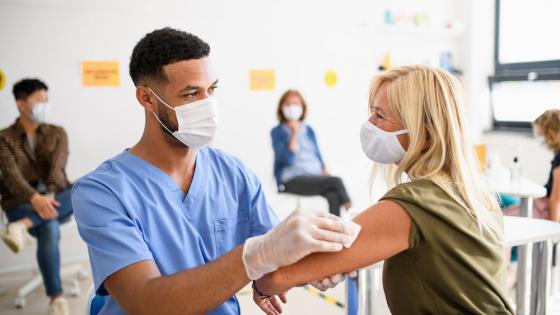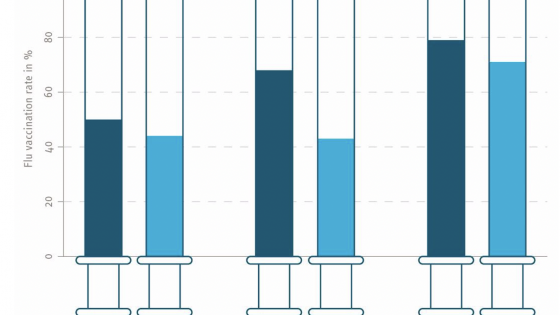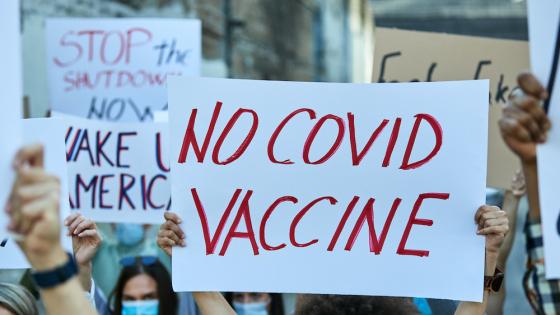COVID-19 vaccines are finally here. Vaccine developers lost no time after the novel coronavirus first made its appearance, at a time when the term ‘COVID-19’ was not yet coined and the known toll could be counted on one hand. And within weeks of the approval of the vaccines, as the year 2020 came to a close, over 10 million people worldwide had been vaccinated.
Staggering as this number might seem, this is merely a fraction of the total number of vulnerable people who need to be vaccinated in order to stop the virus in its tracks. Despite the excitement and hopeful anticipation from the general public, the level of mistrust surrounding the COVID-19 vaccine is deeply concerning. In the US, COVID-19 mortality is disproportionally higher among racial minorities and those with lower income and education levels (Abedi et al. 2020). Similarly, across the globe, over one billion marginalised people face elevated risk of dying from COVID-19 due to overcrowded living conditions in settlements. Structural oppression has exposed these populations to the brunt of this pandemic; it is critical now to take steps to understand how generational trauma and racism in healthcare may contribute to COVID-19 vaccine hesitancy in global settings (Cooper and Crews 2020). Historically, vaccines have been used as a tool of colonialism by ruling elites who imposed vaccines on populations that were denied basic health and human rights, illustrated by the riot of 1904 in Rio de Janiero (Meade 1986) and passive resistance to vaccination against smallpox in India in the early 20th century (Durbach 2007). The Ebola vaccine trial in Sierra Leone, conducted in the aftermath of a raging epidemic and a brutal civil war, highlighted the importance of diversifying communication methods to acknowledge power dynamics within a community, and engaging in dialogues to address concerns arising from past mistrusts (Enria et al. 2016). Other forms of COVID-19 vaccine hesitancy relate to concerns over unknown long-term safety. Approaching vaccine messaging with an inclusive approach towards community needs – encompassing biological, economic, socio-political and moral exigencies – can improve public confidence in vaccination programmes.
A ‘bottom-up’ approach – where the community is a resource and an active partner, not just a passive recipient of services – is critical for rebuilding trust and addressing inequities (Baum 2007). One needs to shift away from a ‘top-down’ approach with central planning by ‘experts’ offering services, and move towards an approach that is a dialogue. A shared partnership among the communities and the experts, immersed in mutual engagement, is what is needed to build trust. Local perspectives and actions identified through a bottom-up approach that provides friendly, convenient, and respectful vaccination services can improve not just COVID-19 vaccine acceptance in communities, but also routine vaccination services.
To identify plausible bottom-up strategies as countries begin to roll out COVID-19 vaccines, public health researchers must work closely with grassroots leaders to identify influential individuals who are unique to these communities. Previous research has supported leveraging this bottom-up approach. Human Papilloma Virus (HPV) vaccine uptake research in Uganda and Vietnam indicated that the involvement of community leaders and local government officials was a catalyst that brought about positive change (Galagan et al. 2013). Formative research our team led in rural India identified that while many vaccination campaigns primarily targeted mothers, a broader involvement of community health workers, mothers-in-law, religious leaders, and community elders may be more impactful for enhancing vaccine uptake (Dhaliwal et al. 2020).
In a nationwide survey, 66% of COVID-19 vaccine-hesitant American residents indicated they would be motivated in favour of vaccination if their peer groups reported a positive experience after obtaining the vaccine, demonstrating the importance of identifying strong channels of influence within a community. Having local champions, including religious influencers and locally elected leaders, speak positively about vaccines could be important for gaining public trust. Influential leaders understand that the public will need to inspired, not shamed into accepting the vaccine. Dr. Anthony Fauci, a household name at this point, received his vaccination on live TV and expressely stated his complete confidence in the vaccine prior to receiving it. Vice President-Elect Kamala Harris went further in her effort to build trust from the ground up among those who are most hesitant – she sought out the hardest-hit, predominately Black community, in Southeast Washington DC, where hesitancy and distrust is high. She received her vaccine at the only public hospital in Washington, and she spoke passionately about individuals receiving their vaccines in local community settings where their roots run deep. Other influencers include community health workers and primary care providers, who form an integral part of the fabric of urban and rural communities. COVID-19 vaccine trial participants, particularly minority populations, can help ease communications about vaccine uptake within these communities (Jaklevic 2020). Celebrities such as Beyonce and Oprah Winfrey, who have already donated to COVID-19 relief, can play a big role in championing ground support for vaccination, just as Elvis Presley once did for the polio vaccine in the 1950s. Of course, along with vaccine distribution policy, it is important to also emphasise the utility of low-cost policy measures against the spread of COVID-19 that are based on evidence; these portfolio of policies will need widespread acceptance and implementation in order to mitigate the negative effects of the pandemic on the economy (Prettner et al. 2020).
A deeper look teaches us that for a COVID-19 vaccine to gain public trust, we must communicate that the effort is not just about saving lives, but also about improving livelihoods. A successful COVID-19 vaccine story does not end with the production of a safe and effective vaccine; rather, the final chapters, and indeed the epilogue, must address the structural disparities and contemporary practices that have lowered community confidence in vaccines. To paraphrase Ray Kinsella in the film “Field of Dreams”, we can build vaccines, and with the proper approach, the people will surely come.
References
Abedi, V, O Olulana, V Avula et al. (2020), “Racial, Economic, and Health Inequality and COVID-19 Infection in the United States”, Journal of Racial and Ethnic Health Disparities, 1 September: 1-11.
Cooper, L A and D C Crews (2020), “COVID-19, racism, and the pursuit of health care and research worthy of trust”, The Journal of Clinical Investigation 130(10): 5033-5.
Meade, T (1986), “’Civilizing Rio de Janeiro’: The Public Health Campaign and the Riot of 1904”, Journal of Social History 20(2): 301-22.
Durbach, N (2007), “Fractures States: Smallpox, Public Health and Vaccination Policy in British India 1800–1947”, Social History of Medicine 20(1): 168-70.
Enria, L, S Lees, E Smout et al. (2016), “Power, fairness and trust: understanding and engaging with vaccine trial participants and communities in the setting up the EBOVAC-Salone vaccine trial in Sierra Leone”, BMC Public Health 16(1): 1140.
Baum, F (2007), “Cracking the nut of health equity: top down and bottom up pressure for action on the social determinants of health”, Promotion & Education 14(2): 90-5.
Galagan, S R, P Paul, L Menezes and D S LaMontagne (2013), “Influences on parental acceptance of HPV vaccination in demonstration projects in Uganda and Vietnam”, Vaccine 31(30): 3072-8.
Dhaliwal, B, R Chandrashekhar, A Rattani, R Seth, S Closser, A Jain, D Bloom and A Shet (2020), “Community Perceptions of Vaccination Among Influential Stakeholders: Qualitative Research in Rural India”, MedRxiv.
Jaklevic, M C (2020), “Researchers Strive to Recruit Hard-Hit Minorities Into COVID-19 Vaccine Trials”, JAMA: The Journal of the American Medical Association 324(9): 826-8.
Prettner, K, S Chen, M Kuhn and D Bloom (2020), “Effective pandemic management that minimises economic harm”, VoxEU.org, 4 January.






